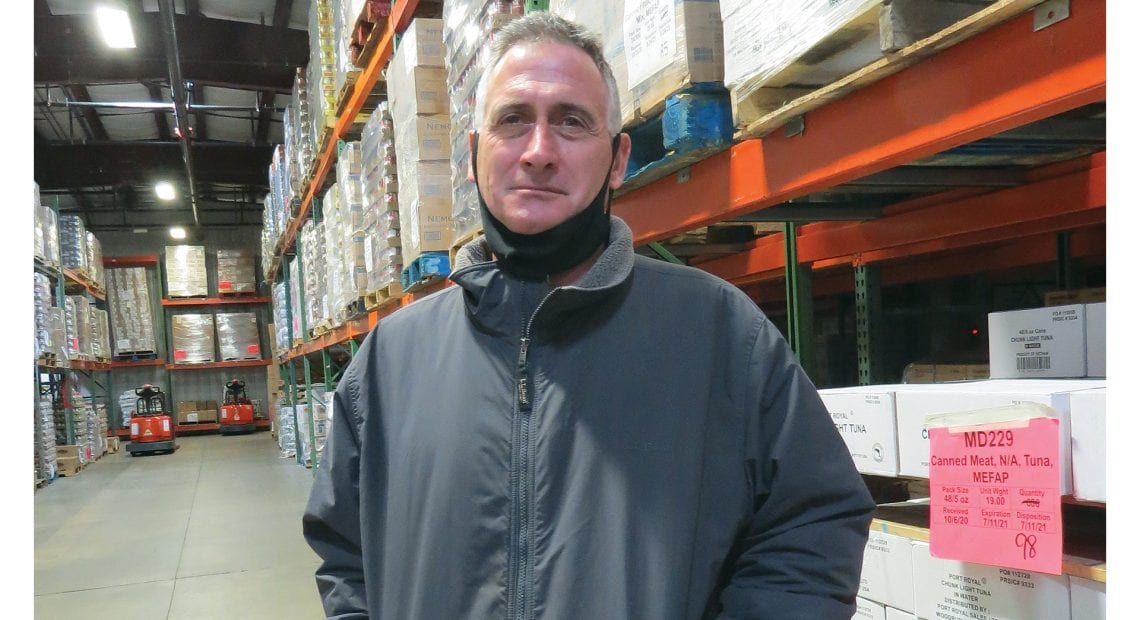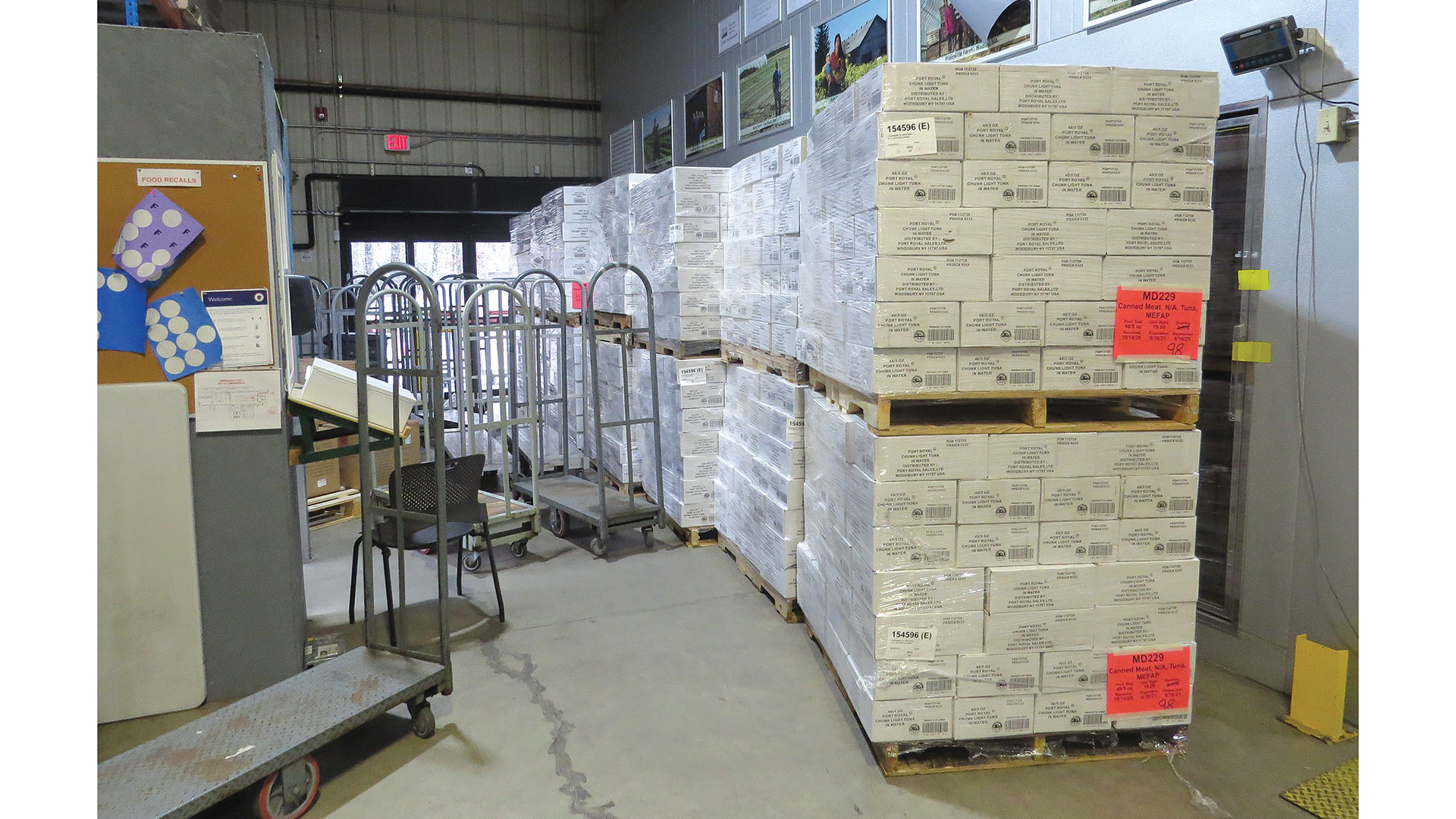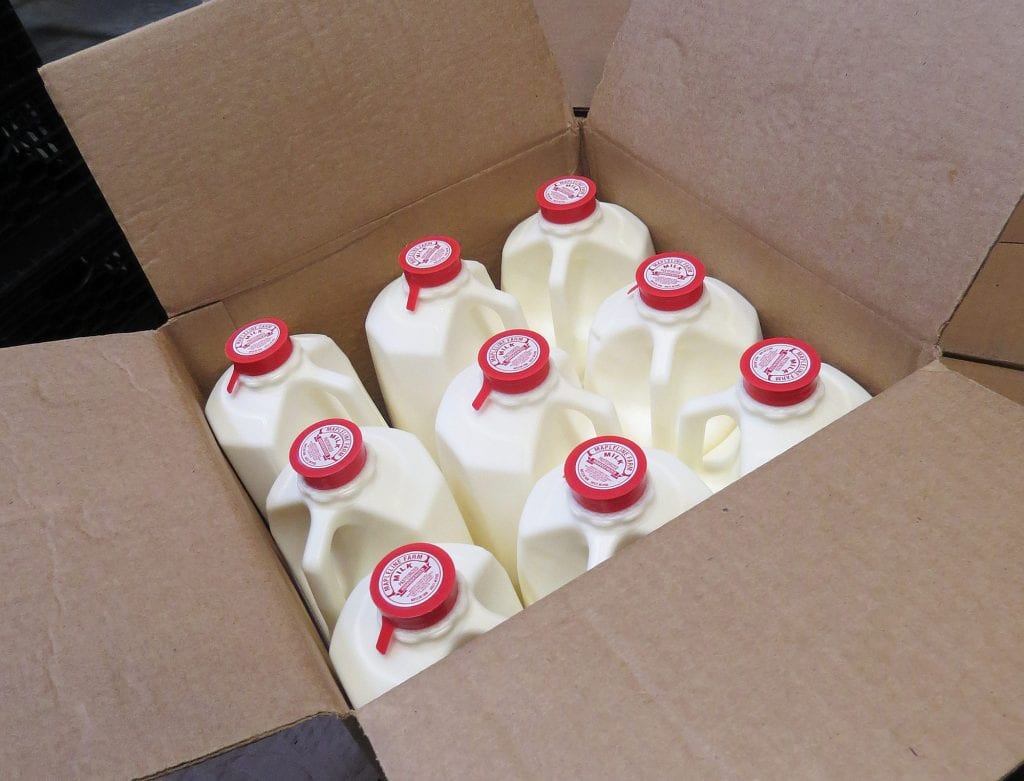
Food Bank Responds to Rising Need Fueled by the Pandemic
Tightening the Safety Net

Andrew Morehouse stands in the warehouse at the Food Bank’s complex in Hatfield.
As Andrew Morehouse conducted his tour of the facilities at the Food Bank of Western Massachusetts, the sights and sounds helped tell the story that is emerging at this agency — and within this region — at a critical time.
The first thing to notice was the copious amounts of food of all kinds — from sweet potatoes in huge bins to hundreds of cases of canned tuna — now stored at the complex in Hatfield and in other locations as well, destined for local meal sites and food pantries. Indeed, the Food Bank is “over capacity,” as Morehouse, its executive director, put it, because of the soaring numbers of people who are now facing food insecurity in the wake of the pandemic, and the way government agencies, businesses, and individuals have responded to those numbers.
This capacity issue was clearly in evidence, with pallets of food stacked not only on the shelves and the floor space of the warehouse, but in the hallways leading to it as well.
“The warehouse is jam-packed; we’re storing food off site, and we’re moving it faster,” he explained. “We’ve brought on additional staff, we’ve purchased another van, we’re about to purchase another truck so we can move food as quickly as possible. The pandemic has put us over the top in a big way, so we’re looking at options for expansion.”
As for the sounds … well, the Food Bank was mostly quiet at the hour of this visit — late morning, approaching noon — but the few workers on the floor were talking about what they witnessed in the parking lot of Central High School in Springfield, where a drive-thru food-distribution site, supported in part by the Food Bank, has been established. The staffers were talking about long lines of vehicles, and how this has become a constant, or a new norm, with this initiative.
“The warehouse is jam-packed; we’re storing food off site, and we’re moving it faster. We’ve brought on additional staff, we’ve purchased another van, we’re about to purchase another truck so we can move food as quickly as possible. The pandemic has put us over the top in a big way, so we’re looking at options for expansion.”
Meanwhile, fewer people are working at the Hatfield facility, with many more working remotely because of the pandemic, and a host of safety protocols in place to keep those who do come in — and the public in general — safe.
In many ways, the Food Bank — and the hundreds of sites it serves — has become one of the enduring symbols of this pandemic locally. Indeed, just as the bread lines of the mid-1930s became an indelible image that came to represent the Great Depression, the long lines of motorists picking up food — it can no longer be distributed indoors — have come to symbolize this pandemic.
And as fall continues and winter approaches, need is only expected to grow, said Morehouse, who cited projections from Feeding America showing that, by year’s end, an estimated one in six residents in Western Mass. (perhaps 127,000 people) will be experiencing food insecurity, as opposed to one in 10 before the pandemic began, and one in four children. That would be a 40% increase in the number of people overall, and a more than 60% increase in the number of children.
In many ways, such numbers help tell this story. During the fiscal year that just ended Sept. 30, the Food Bank distributed 14.8 million pounds, or the equivalent of 12 million meals — a 23% increase over the previous year, compared to an average 6% increase year over year. Meanwhile, over the past seven months, the increase has been roughly 30% (from 7.3 million pounds to 9.5 million), much higher than the annual increase, obviously, because of the direct impact of the pandemic, and the highest seven-month spike in the agency’s 38-year history.
Behind the numbers, though, is the inspiring story of how the region and its business community have responded to the crisis, said Morehouse, adding that this response was quick and profound, and it is ongoing.

Sweet potatoes from local farms are among the many items jamming the shelves and floor space at the Food Bank, which is over capacity due to spiking need.
The biggest question concerns what comes next, and it’s one that’s hard to answer, he noted, adding that many factors will go into determining where these numbers go in the weeks and months to come.
For this issue, BusinessWest talked at length with Morehouse about the mounting problem of food insecurity in the wake of the pandemic and how his agency has responded. Overall, he said this response “is how the safety net is supposed to work.”
Elaborating, he noted that the Food Bank has been able to meet soaring need because federal and state agencies have stepped up and put more food into the system, but also because the region has stepped up as well.
Food for Thought
As he talked about what has transpired since March, when the pandemic arrived in Western Mass., Morehouse said it’s been a period of adjustment — for area residents, for his agency, and even for area farms.
For many, the pandemic left them unemployed or in a position where they were earning less — although generous unemployment benefits certainly helped large numbers of people impacted by the downturn in the economy. But those unemployment benefits also had the unintended consequence of leaving individuals ineligible for SNAP (Supplemental Nutritional Assistance Program) benefits, creating a different kind of problem.
For the Food Bank, the first several weeks of the pandemic were chaotic, he said, as the agency mounted a response to what was happening — but had to do so in the middle of a health crisis.
“There was a lot of uncertainty about how to protect oneself from COVID-19, and suddenly, so many people lost their jobs or were furloughed,” he explained. “There was an outpouring of concern, of wanting to help, from people who don’t know that an emergency food network exists. So we were fielding calls from community groups from all across Western Massachusetts, saying, ‘we want to bring food to the Food Bank,’ or ‘how can we support you?’
“And it took a while for us to connect people to the pantries and meal sites in their communities as a way to support households that were at risk of hunger, because that’s who we work with,” he went on. “We don’t receive individuals who are in need of food assistance at our warehouse, and we don’t deliver food to households; we work through the existing network of about 165 independent pantries and meal sites, plus our own distribution programs to 51 senior centers every month, and on our mobile food bank, which has 26 distribution sites across all four counties on a biweekly or monthly basis.”
When asked how the Food Bank responded to that 30% spike over the past seven months, Morehouse replied with a quick “it wasn’t easy,” before elaborating.

Pallets of food destined for area meal sites and pantries spills out into the hallways at the Food Bank, clear evidence of soaring need in the region.
“It took us a while to catch up, I’ll be honest,” he told BusinessWest, noting that there were a number of challenges to overcome, starting with disruption to what he called the “supply chain,” meaning donations of food to the agency from individuals and also, and especially, area supermarkets.
“There was a run on those supermarkets, so it was a significant hit,” he recalled, adding that roughly half the food distributed by the agency comes from the private food industry in the form of dry goods, produce, and close to 1 million pounds of meats frozen on the sell-by date.
Beyond this disruption to the supply chain, the Food Bank was impacted by shortages of staff and a loss of many of its distribution sites; several of them closed, including all brown-bag sites for elders and many mobile locations.
Slowly, over time, those sites reopened, while also changing how food was distributed, he noted, adding that as, the spring progressed, the Food Bank adapted to what became a new normal, both in terms of how it operated and with the numbers of people now facing food insecurity.
Indeed, over the period from March to August, the latest information available, the average number of individuals served each month grew to 107,000, Morehouse said, adding that 20,000 of those, or 19%, are people who have never come to a pantry or meal site.
And that percentage of new visitors was much higher, perhaps 40%, in the early weeks of the pandemic, when the layoffs and furloughs started climbing, and before those generous unemployment benefits kicked in. The numbers then leveled off for a time, but they started climbing again, he went on, adding that, when the new six-month numbers come out, the total people being served should far surpass that 107,000 figure.
Numbers to Chew On
Behind the numbers is the story of how this rising demand has been met with the help of a number of contributing sources — that safety net Morehouse described earlier.
These include the federal government, state agencies, area businesses, and philanthropic efforts like Jeff Bezos’ $100 million gift to Feeding America’s COVID-19 Response Fund.
“The federal government has stepped up — we’ve received considerably more federal food,” he explained, referring specifically to CARES Act appropriations that enable such agencies to buy more food. “And there was an outpouring of support from individuals, businesses, and regional and state foundations, as well as from Feeding America, the national network of food banks.”
The agency has also received more than $400,000, with another $123,000 coming, from the Massachusetts COVID Relief Fund, he went on, adding that a number of individual businesses, including Big Y and the Antonocci Family Foundation, have made sizable donations as well.
Part of the federal government’s response has come in the form of Farmers to Families Food Boxes, a new program through which the USDA’s Agricultural Marketing Service is partnering with national, regional, and local distributors, whose workforces have been significantly impacted by the closure of restaurants, hotels, and other food-service businesses, to purchase up to $4.5 billion in fresh produce, dairy, and meat products from American producers of all sizes.

Mapleline Farm in Hadley is one of several local farms in the region that have adjusted with the pandemic, now supplying the Food Bank with milk in family-sized packaging.
This program supplies boxes of fresh fruits and vegetables, dairy products, and meat products, which distributors package into family-sized boxes, then transport them to food banks, community and faith-based organizations, and other nonprofits serving Americans in need.
The program has benefited several area farms, said Morehouse, noting that those supplying the boxes are purchasing products from many area farmers who were severely impacted by their inability to sell to restaurants, colleges, and universities closed by the pandemic.
“It took a while for some of these farms to adapt, but many of them have,” he said, citing, as one example, Mapleline Farm in Hadley, a dairy farm whose name and logo were on countless boxes of quart containers of milk in the Food Bank’s warehouse.
As for the future, Morehouse said the contributions that have poured in from individuals and businesses have left the organization in a solid position financially for this current fiscal year, one in which overall need is expected to continue growing, while the economy is projected to continue struggling.
Meanwhile, question marks remain about the ongoing level of support from state and federal governments, as well as from individual contributors, he said, citing the potential for donor fatigue as the pandemic wears on.
“The state is operating on a month-to-month budget, so we’re not even sure if we’re going to be level-funded for a program that we’ve come to rely on for 30% of our food since 1992,” he told BusinessWest. “And the federal government has not passed another stimulus package, so we’re anticipating a decline in federal support.
“We have a jigsaw puzzle of public and private emergency food resources that rely of federal and state funding and private charitable support,” he went on. “We rely on all those sources of support to get the food we need and the resources we need to keep operations afloat.”
One of the important pieces of that puzzle is Monte’s March, the fundraising walk from Springfield to Greenfield that was launched by radio personality Monte Belmonte to benefit the Food Bank. Belmonte has seen the ranks of people joining him on his late-November trek grow steadily over the years, as well as the amount raised for the agency, but that first trend won’t continue this year, as the pandemic is forcing organizers to encourage individuals to support the march remotely — although the top-performing teams when it comes to generating donations will be able to march.
But, given the urgent need for support, they are hoping the second trend will continue. The goal for this year has been raised from the $333,000 mark set last year — each dollar donated buys three meals, so the goal was to fund 1 million meals — to $365,000, or $1,000 a day, or 4,000 meals a day (one dollar now buys four meals, due to greater efficiency).
Hard to Digest
Looking at the projections from Feeding America for the next several months, the ones predicting that one in six area residents will be food-insecure, Morehouse had his doubts initially about whether things would really get that bad here.
But now, he’s thinking they may be realistic — painfully realistic, to be more precise — especially when one ponders the unanswerable questions concerning when the pandemic will subside and to what degree the federal government will keep on printing money.
One thing Morehouse does know is that the Food Bank will continue to pivot and respond proactively to the ongoing crisis — right down to finding more warehouse space.
George O’Brien can be reached at [email protected]




